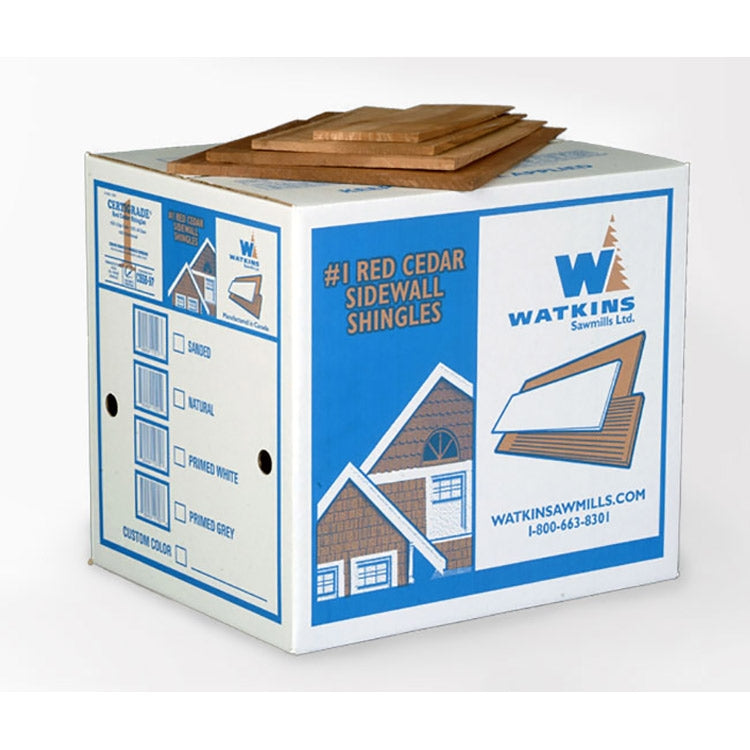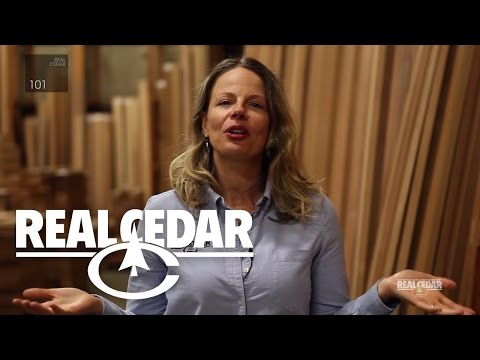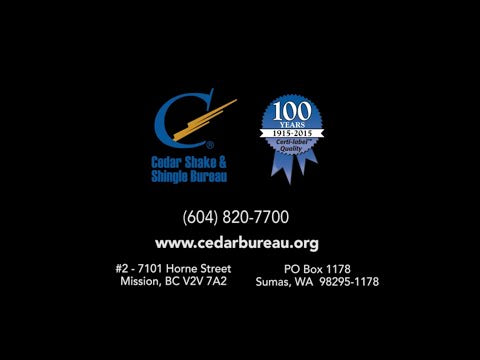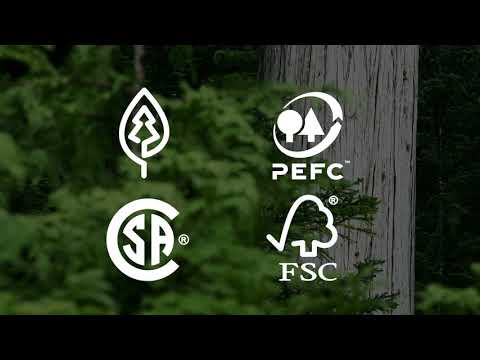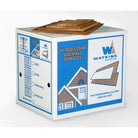Box #1 Grade 18” Perfection Western Red Cedar R&R Shingles - Watkins Sawmills
Please call for a custom shipping quote if you need 10 or more boxes.
Details
Bring warmth and durability to your home with #1 Grade 18” Perfection Kiln-Dried Western Red Cedar R&R Sidewall Shingles. Many plastic and composite products on the market attempt to duplicate the look of cedar siding, but none match the beauty and distinctiveness of naturally-grown cedar. Our Western Red Cedar R&R (Rebutted and Rejoined) Sidewall Shingles are trimmed with parallel edges and butts sawn at right angles for true ease of installation. Western Red Cedar shingles can be stained, painted, or allowed to weather naturally. Available in both Natural and Grooved finishes, real cedar shingles are a low maintenance addition that offers dimension, distinctiveness, and durability to your home.
Texture Options:
• Natural texture: The shingle face has a light rough texture.
• Grooved texture: Vertical grooves are cut on the face of the shingle to produce given a more textured, "combed" appearance.
Features & Benefits of Western Red Cedar Shingles:
• Extreme Durability – Cedar Shingles easily withstand harsh weather conditions including heavy wind, rain, and hail.
• Longevity – Western Red Cedar is known as one of the most durable softwoods, and with proper maintenance, Cedar Shingles can beautify your home for decades.
• Energy Efficiency – Cedar is an excellent source of insulation, keeping your home warmer during cold months and allowing your home to breathe and stay cooler during the warmer months, all while maintaining a low carbon footprint.
• Termite Resistance – Western Red Cedar wood is naturally resistant to termites.
• Ease of Installation – Cedar Shingles are easy to install and perfect for a Do-It-Yourself project.
• Versatility – Western Red Cedar Shingles can be used with many different architectural styles, affording you the option of a home covered in beautiful Cedar wood, or simply a small rustic accent area on an otherwise traditional home.
• Quality Milling – We sell only the highest quality Cedar products.
• Adaptability – Cedar Shingles are manufactured to be used on both interior and exterior wall surfaces.
Product Specifications:
• Length: 18" (Perfection)
• Grade: CSSB #1 Grade (Blue Label). Bureau certified grading. Clear Heartwood, 100% edge grain, no defects
• Side and Edge Cuts: Rebutted & Rejointed (R&R). R&R shingles are trimmed for parallel edges with the butts sawn at right angles.
• Drying: Kiln-Dried
• Texture Options: Natural (sawn texture on face) and Grooved (combed texture on face)
• Packaging: Shingle box measuring 20"x18"x18". This box is sized to yield 100 square feet of wall coverage if fastened at 14" shingle exposure.
• Thickness: 0.45" thickness at Butt
• Courses per Carton: 56
• Exposure Options: 4”-14”
• Width: Shingles can vary from 4”-8” wide.
• Use Area: R&R Shingles are rated for sidewall application only. They are not recommended as a roofing material.
Special Order Options:
This product is also available as special order from the manufacturer with the following options. Please call us for current pricing and lead times.
• Sanded Smooth, Primed White, Primed Gray
• FSR Fire Retardant Treatment in Class A, Class B, or Class C protection
Coverage Rate Information:

• When using double coursing, this product has a maximum exposure of 14".
• When using single coursing, this product has a maximum exposure of 8".
Single Coursing Vs. Double Coursing Application Methods:
• Using the single coursing application method, they are installed with one layer of shingles per run.
• Using the double coursing method, two shingles are installed on top of each other on every layer. This method allows more of the face of each shingle to be exposed, providing more square footage of coverage from each box of shingles. Double exposure application also saves money on material and produces a more noticeable shadow line.
Estimating Cedar Shingles:
1. Start by measuring the amount of square footage you have to cover.
2. Each box will vary in the amount of completed coverage it will yield based on the width of exposure you choose. Exposure is the height in inches of the shingle face not covered by the next shingle course. Generally, the wider the exposure, the more coverage you will get from the box.
3. Using the chart above, identify the amount of coverage per box at your desired exposure.
4. Divide the square footage of coverage needed by the square footage per box value that you just selected from the chart.
Example: 500 square feet of wall needs to be covered using #1 grade perfection cedar sidewall shingles. The highest level of exposure is desired; therefore, the shingles should be installed as a double course with a 14" exposure. At a 14" exposure, each box of shingles should yield 100 square feet of coverage. So, divide the 500 square feet of wall coverage by the 100 square feet of coverage per box. At this exposure, 5 boxes should be needed to complete the job.
Product Resources:
Guide to Rebutted/Rejointed Shingles and Machine Grooved Shakes
Cedar Shake and Shingle Specification Guide
Basics Guide for Cedar Shakes and Shingles
CSSB Exterior and Interior Wall Manual
Specifications
More Information
|
Additional Resources for 18” Perfection Western Red Cedar R&R Shingles: Watkins Sawmills Certifications: Application Notes: Single Coursing Western Cedar Shingle Installation: Finishing Cedar Shingles: Nails: Staples: |
Reviews
Product Questions
Product Questions
-
Can I use R&R shingles on a roof?
The Watkins Sawmill #1 18" Perfection R/R shingles are typically used as a sidewall shingle and are not recommended for roof application.
-
What's the difference between the boxes of #1 R&R Shingles and the bundles of #1 Shingles?
The R/R Western red cedar shingles are trimmed for parallel edges with the butts sawn at right angles. The regular #1 18" cedar shingles do not have this feature but are still a very nice alternative to the R/R shingle.
-
What is indicated with "Perfection" in the name?
Perfection just indicates that the shingle is 18" long. Other cedar shingle sizes have similar nicknames: 16" shingles are also referred to as "Fivex" shingles and 24" shingles are also referred to as "Royals".
-
What does R&R stand for in the name?
An R&R Shingle has been Rebutted and Rejointed. This means that the shingle has been trimmed for parallel edges with butts sawn at right angles. This results in the shingle having a cleaner and more uniform appearance.
-
Hi are these shingles sanded smooth?
This is the "Natural" version of the R&R shingles which has a light rough texture. The Natural and Machine Grooved textures are normally stock items. We can also have the sanded smooth version of this same item brought in if you'd like.
| Product Details | |
|---|---|
Grade |
|
Drying |
|
Courses Per Carton |
|
Shingle Length |
|
Thickness Average thickness of shingle/shake at the butt (bottom) end
|
|
Width |
|
Typical Bundle Dimensions |
|
Side and Edge Cuts |
|
Edges Parallel |
|
Inches Per Bundle Total inches of width of “on-grade” shakes/shingles per unit (bundle or box).
|
|
| Installation Details | |
Application Type |
|
Standard Sizing |
|
Exposure - Sidewall Refers to options on the length of the shake that can be exposed to the weather. Wider exposures yield more square feet of coverage per bundle.
|
|
Fastener - Sidewall |
|

